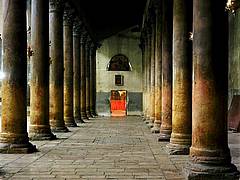New sites have been
inscribed on UNESCO’s World Heritage List: Birthplace of Jesus: the Church of
the Nativity and the Pilgrimage Route, Bethlehem (Palestine); Site of Human
Evolution at Mount Carmel: The Nahal Me’arot/Wadi el-Mughara Caves (Israel),
Rock Islands Southern Lagoon (Palau), and The Cultural Landscape of Bali: the
Subak System as a Manifestation of the Tri Hita Karana Philosophy (Indonesia),
Rabat, modern capital and historic City: a shared heritage (Morocco).
Inscriptions are expected to continue today and tomorrow.
Birthplace
of Jesus: the Church of the Nativity and the Pilgrimage Route, Bethlehem
(Palestine) was also placed on the List of World Heritage in Danger as it is
suffering from damages due to water leaks. The inscribed property is situated
10km south of Jerusalem on the site identified by Christian tradition as the
birthplace of Jesus since the 2nd century. A church was first completed there
in 339 A.D. and the edifice that replaced it after a fire in the 6th century
retains elaborate floor mosaics from the original edifice. The site also
includes Latin, Greek Orthodox, Franciscan and Armenian convents and churches,
as well as bell towers, terraced gardens and a pilgrimage route.
Site of
Human Evolution at Mount Carmel : The Nahal Me’arot/Wadi el-Mughara Caves
(Israel) on the western slope of the Mount Carmel range, includes the cave
sites of Tabun, Jamal, el-Wad and Skhul. It covers 54 hectares and contains
cultural deposits representing 500,000 years of human evolution with evidence of
burials, early stone architecture and the transition from a hunter-gathering
lifestyle to agriculture and animal husbandry. The site demonstrates the unique
existence of both Neanderthals and Early Anatomically Modern Humans (EAMH)
within the same Middle Paleolithic cultural framework, the Mousterian. As such,
it has become a key site of the chrono-stratigraphic framework for human
evolution in general, and the prehistory of the Levant in particular. Ninety
years of archaeological research have revealed a cultural sequence of
unparalleled duration, providing an archive of early human life in south-west
Asia.
Rock Islands
Southern Lagoon (Palau) covers 100,200-hectare and numbers 445 uninhabited limestone islands
of volcanic origin. Many of them display unique mushroom-like shapes in
turquoise lagoons surrounded by coral reefs. The aesthetic beauty of the site
is heightened by a complex reef system featuring over 385 coral species and
different types of habitat. They sustain a large diversity of plants, birds and
marine life including dugong and at least 13 shark species. The site harbours
the highest concentration of marine lakes anywhere, isolated bodies of seawater
separated from the ocean by land barriers. They are among the islands’
distinctive features and sustain high endemism of populations which continue to
yield new species discoveries.
Cultural
Landscape of Bali: the Subak System as a Manifestation of the Tri Hita Karana
Philosophy (Indonesia) forms a cultural landscape of five rice terraces and their water
temples that cover 19,500 hectares. The temples are the focus of a cooperative
water management system of canals and weirs, known as subak,that dates back to
the 9th century. Included in the landscape is the 18th-century Royal Temple of
Pura Taman Ayun, the largest and most impressive architectural edifice of its
type on the island. The subak reflects the philosophical concept ofTri Hita
Karana, which brings together the realms of the spirit, the human world and
nature. This philosophy was born of the cultural exchange between Bali and
India over the past 2000 years and has shaped the landscape of Bali. The
subaksystem of democratic and egalitarian farming practices has enabled the
Balinese to become the most prolific rice growers in the archipelago despite
the challenge of supporting a dense population.
Rabat,
modern capital and historic City (Morocco): a shared heritage, on Atlantic coast in the northwest of the country, is the product
of a fertile exchange between the Arabo-Muslim past and Western modernism. The
inscribed city encompasses the new town conceived and built under the French
Protectorate from 1912 to the 1930s, including royal and administrative areas,
residential and commercial developments and the Jardins d’Essais botanical and
pleasure gardens. It also encompasses older parts of the city dating back to
the he 12thcentury. The new town is one of the largest and most ambitious
modern urban projects built in Africa in the 20th century and probably the most
complete. The older parts include Hassan Mosque (started in 1184) and the
Almohad ramparts and gates, the only surviving parts of the project for a great
capital city of the Almohad caliphate as well as remains from the Moorish, or
Andalusian, principality of the 17th century.

UNESCO/Federico
Busonero - Nativity Church, Bethlehem
